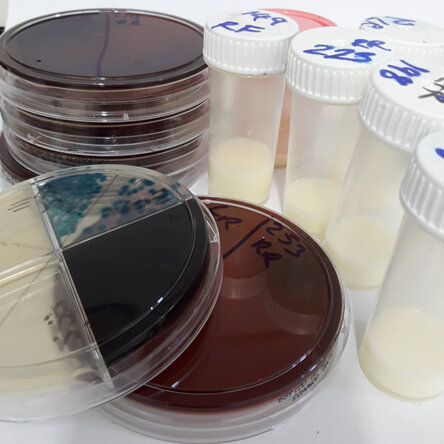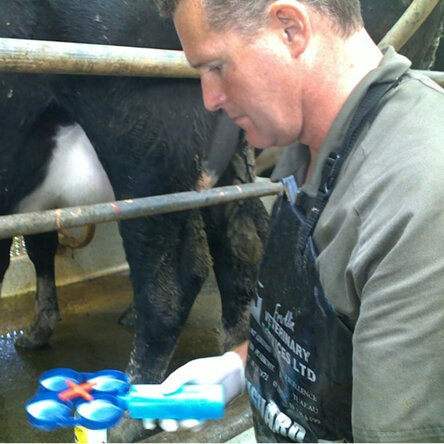Franklin Vets
Franklin Vets - excellence in veterinary care for dairy, farming, lifestyle, equine and household pets. BESTPRACTICE ACCREDITED NZ.

There are several ways to do this including bacterial culture, multiple herd test cell counts, single herd test cell counts, rapid mastitis testing at drying-off, in-line mastitis detection meters, and other testing. They each have benefits and limitations including the following:
This is arguably the “Gold Standard” for determining the presence of bacteria in the udder, taking milk samples from each quarter, and incubating them on various growth media to see whether bacteria grow from the sample. Several companies including Franklin Vets offer this service where cows are sampled, and diagnostic processes provide information on a limited range of bacteria that are identified. Cows from which bacteria are grown can be managed accordingly, either treated with antibiotic DCT, culled, or monitored. The whole herd, or a subset of the herd can be sampled depending on the goals of the farm.
This provides a high level of information on the types of bacteria present, how to prevent infection in the future and whether you can expect low, medium or high cure rates following treatment. Its biggest drawback is the cost. Processing hundreds of cows in the case of a whole herd sample is time-consuming and therefore expensive.
Large elevations in ICSCC, are in most cases caused by the presence of bacteria in the udder. A threshold of ≥ 150,000 cells/ml of milk at any herd test during the season has been used over the past three decades in NZ to determine whether a cow is likely to be infected with bacteria at the end of lactation. While the threshold of 150,000 cells/ml will call many “clean” cows “infected”, it does catch over 90% of the cows that are genuinely infected with bacteria and that could benefit from antibiotic DCT. It continues to be the backbone of diagnostic evidence to support the use of antibiotic DCT in infected cows.
This provides a relatively easy way to assess whether a cow is likely to be infected and is relatively low cost when combined with other reasons for herd testing. Its main drawback is that there will be more cows treated than necessary in most herds.
How many herd tests do you need?
Four herd tests are advocated for a variety of very sound reasons including the ability to review the performance of previous DCT strategies, to calculate new infection rates during lactation and gain insight into mastitis control strategies, and to determine which cows should be considered for antibiotic treatment in a partial herd treatment strategy at drying-off. However, a single herd test about 60 to 80 days out from drying-off will provide reasonable diagnostic evidence from which to plan drying-off treatment.

Not herd testing (i.e., not having any diagnostic evidence) will not be sufficient cause to allow herds to be blanket treated with antibiotic DCT. The rapid mastitis test (RMT) during the week of drying-off will provide reasonable diagnostic evidence upon which to base this decision. The RMT is an indirect test that most of you will be familiar with, having used it cow side to detect subclinical mastitis. It can be used at a cow level or at a quarter level to determine when to use antibiotics. A technician tests ahead of the cows to determine which cows or quarters are to receive antibiotic DCT and marks the udder accordingly.
This can be used in the absence of other diagnostic evidence. Its main drawback is that to provide reasonable information, the operator conducting the RMT must be able to identify a trace reading. The ability to do so is less common than some might think and often is best undertaken by a vet or veterinary technician.
Where farms have in-line conductivity or cell count meters built into the hardware of the milking plant, the information derived from these systems is also able to be used to provide diagnostic evidence to support antibiotic DCT use. These measure changes in the milk that are associated with bacterial infection. They tend to be less sensitive for detecting infection on any given day, but with data collected over a period of time provide reasonable diagnostic evidence.
Given that they are built into the hardware, these systems provide information very cheaply. Their main drawback is that it can be difficult to present the information from their software in a format that is easily accessible and interpretable by the veterinarian. If you have these systems on your farm, discuss with your local vet how you will manage access to the information well ahead of drying off.
PCR and ELISA-based tests are available and marketed to detect specific bacteria. These are most appropriate to detect bacteria that mean the cow infected may be suitable for culling rather than treatment. While they provide adjunctive diagnostic evidence, this is not appropriate for determining which cows to treat with antibiotics or teat sealants at a herd level at drying-off.
There are multiple methods of providing diagnostic evidence to support the appropriate use of antibiotic DCT and you should not feel you will be unable to provide this information. It will be worth discussing early in the season how you plan to provide this information with your vet.
Dr David Hawkins BVSc Farm Vet & Consultant